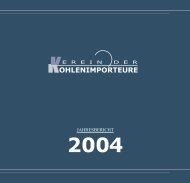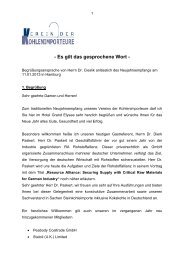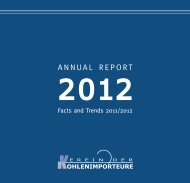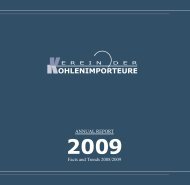Annual Report 2010 - Verein der Kohlenimporteure eV
Annual Report 2010 - Verein der Kohlenimporteure eV
Annual Report 2010 - Verein der Kohlenimporteure eV
You also want an ePaper? Increase the reach of your titles
YUMPU automatically turns print PDFs into web optimized ePapers that Google loves.
the necessary investment in solar equipment, there is a<br />
transfer of wealth from poorer consumers to the owners<br />
of solar plants via electricity tariffs.<br />
Renewable Energy Sources Act: Quantities<br />
and Subsidies<br />
TWh Million euro<br />
120,0<br />
100,0<br />
80,0<br />
60,0<br />
40,0<br />
20,0<br />
0,0<br />
2005 2007 2009 2011 2013 2015<br />
Figure 29: EEG Expenditure<br />
Other Wind Subsidies<br />
25.000<br />
20.000<br />
15.000<br />
10.000<br />
5.000<br />
World up-side-down on the European Energy<br />
Exchange: Negative electricity tariffs<br />
On the European Energy Exchange in Leipzig,<br />
electricity prices slip more and more frequently into<br />
the red, i.e. on the spot market, prices fluctuate in a<br />
negative range. Anyone who purchased at this moment<br />
not only received free electricity, but also a premium for<br />
<br />
the end of 2009, electricity prices were negative on 29<br />
days. The reason for this absurd world? The German<br />
<br />
with the result that when there is a lot of wind, huge<br />
amounts of renewable electricity are fed into a grid that<br />
has not been developed over the years to transport this<br />
excess electricity to those German regions with high<br />
consumption. If a weak demand for power coincides<br />
with high quantities of electricity from wind, grids<br />
become unstable, prices collapse and power producers<br />
offer customers on the energy exchange money to take<br />
the surplus quantities of electricity.<br />
0<br />
A faster reduction of the subsidies for wind energy<br />
should be called for. A further increase in wind energy<br />
subsidies for “repowering” would be completely wrong<br />
in terms of rational policy, because “repowering”<br />
should just lower the production costs.<br />
BDEW predicts EEG costs for power generation from<br />
renewable energy sources (2009-2015) as follows:<br />
We must now wait to see if the revision of the EEG<br />
in 2011 will again result in only slight corrections. A<br />
subsidy mentality has become deeply rooted in the<br />
renewables industry.<br />
€14 billion Subsidy for EEG Expected in 2011 – The<br />
Trend is Still Upwards<br />
Initial estimates indicate that subsidies will increase in<br />
2011 due to the over-supply of renewable electricity. An<br />
estimated feed-in payment of €19 billion for electricity<br />
with a market value of €4.5 billion points to a subsidy<br />
of probably over €14 billion, to be paid by consumers<br />
through the EEG levy. In the medium-term, i.e. by 2015,<br />
the annual EEG levy will amount to approximately €21<br />
billion.<br />
<br />
of €2 Trillion – EEG Subsidies Belong in<br />
<br />
The management consultant McKinsey estimates the<br />
additional costs of renewables at more than €2 trillion<br />
– i.e. two thousand billion euros – in a study of the costs<br />
of unilateral actions within the European Union to 2050.<br />
According to the study, even with a common approach<br />
across Europe – which is nowhere near – a radical<br />
transfer to renewable energies from 2020 to 2050 will<br />
cost at least €6.6 trillion. By a co-ordinated development<br />
of renewable energies in Europe and of the necessary<br />
networks, costs however would drop dramatically.<br />
57








